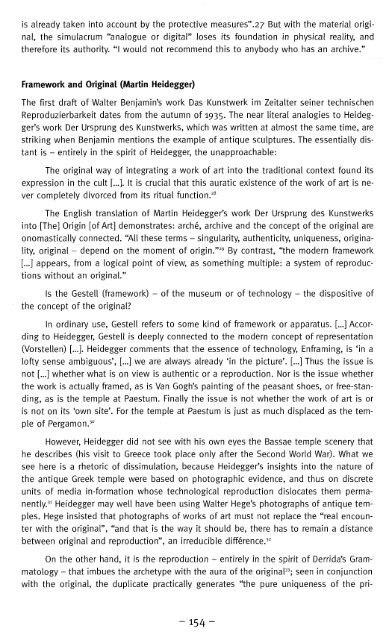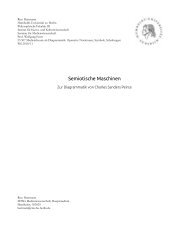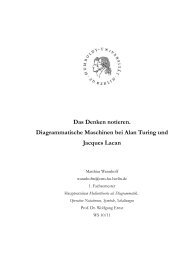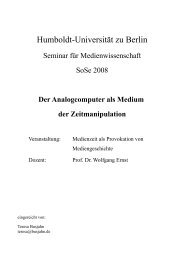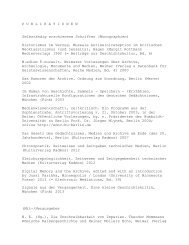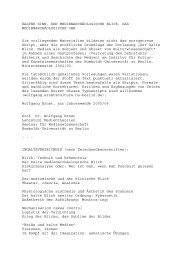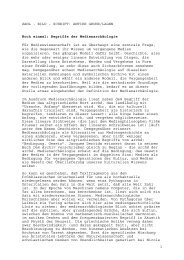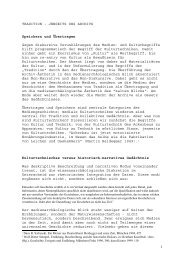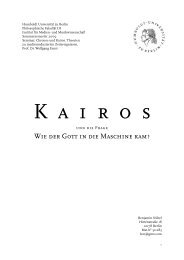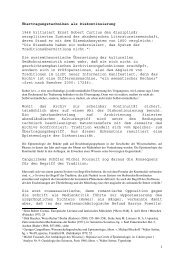Download - Medienwissenschaft
Download - Medienwissenschaft
Download - Medienwissenschaft
You also want an ePaper? Increase the reach of your titles
YUMPU automatically turns print PDFs into web optimized ePapers that Google loves.
is already taken into account by the protective measures".27 But with the material original,<br />
the simulacrum "analogue or digital" loses its foundation in physical reality, and<br />
therefore its authority. "I would not recommend this to anybody who has an archive."<br />
Framework and Original (Martin Heidegger)<br />
The first draft of Walter Benjamin's work Das Kunstwerk im Zeitalter seiner technischen<br />
Reproduzierbarkeit dates from the autumn of 1935. The near literal analogies to Heidegger's<br />
work Der Ursprung des Kunstwerks, which was written at almost the same time, are<br />
striking when Benjamin mentions the example of antique sculptures. The essentially distant<br />
is - entirely in the spirit of Heidegger, the unapproachable:<br />
The original way of integrating a work of art into the traditional context found its<br />
expression in the cult [...]. It is crucial that this auratic existence of the work of art is never<br />
completely divorced from its ritual function. 28<br />
The English translation of Martin Heidegger's work Der Ursprung des Kunstwerks<br />
into [The] Origin [of Art] demonstrates: arche, archive and the concept of the original are<br />
onomastically connected. "All these terms - singularity, authenticity, uniqueness, originality,<br />
original - depend on the moment of origin." 29 By contrast, "the modern framework<br />
[...] appears, from a logical point of view, as something multiple: a system of reproductions<br />
without an original."<br />
Is the Gestell (framework) - of the museum or of technology - the dispositive of<br />
the concept of the original?<br />
In ordinary use, Gestell refers to some kind of framework or apparatus. [...] According<br />
to Heidegger, Gestell is deeply connected to the modern concept of representation<br />
(Vorstellen) [...]. Heidegger comments that the essence of technology, Enframing, is 'in a<br />
lofty sense ambiguous', [...] we are always already 'in the picture'. [...] Thus the issue is<br />
not [...] whether what is on view is authentic or a reproduction. Nor is the issue whether<br />
the work is actually framed, as is Van Gogh's painting of the peasant shoes, or free-standing,<br />
as is the temple at Paestum. Finally the issue is not whether the work of art is or<br />
is not on its 'own site'. For the temple at Paestum is just as much displaced as the temple<br />
of Pergamon. 30<br />
However, Heidegger did not see with his own eyes the Bassae temple scenery that<br />
he describes (his visit to Greece took place only after the Second World War). What we<br />
see here is a rhetoric of dissimulation, because Heidegger's insights into the nature of<br />
the antique Greek temple were based on photographic evidence, and thus on discrete<br />
units of media in-formation whose technological reproduction dislocates them permanently.<br />
31 Heidegger may well have been using Walter Hege's photographs of antique temples.<br />
Hege insisted that photographs of works of art must not replace the "real encounter<br />
with the original", "and that is the way it should be, there has to remain a distance<br />
between original and reproduction", an irreducible difference. 32<br />
On the other hand, it is the reproduction - entirely in the spirit of Derrida's Grammatology<br />
- that imbues the archetype with the aura of the original 33 ; seen in conjunction<br />
with the original, the duplicate practically generates "the pure uniqueness of the pri-<br />
-154-


